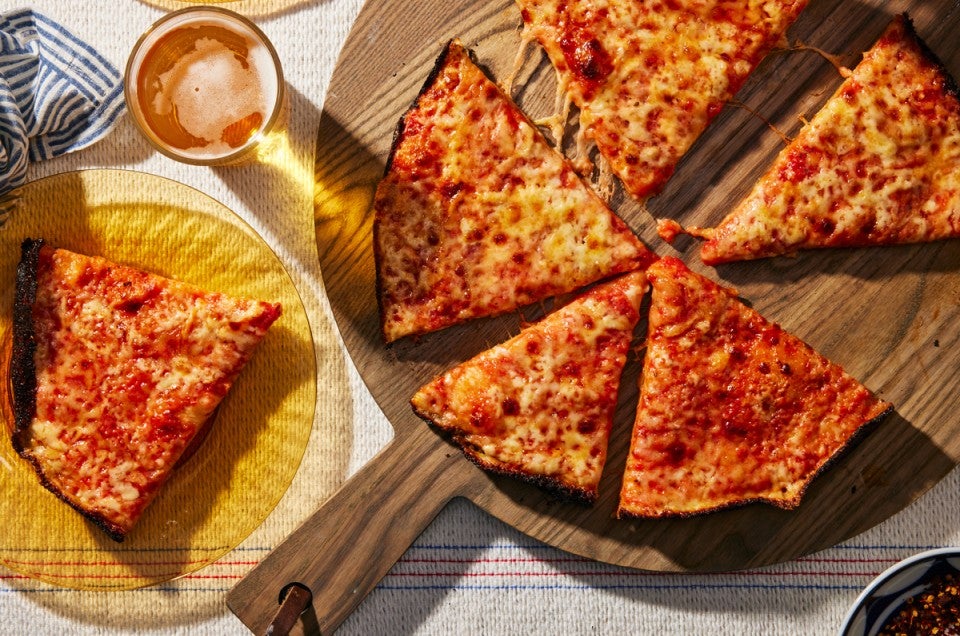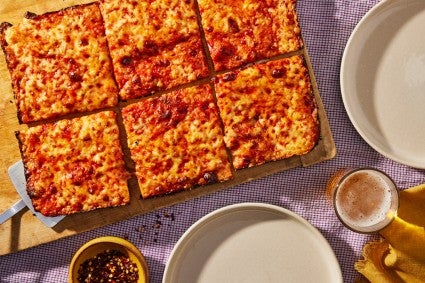Our new favorite pizza is this hyper-local, super-crispy style from the South Shore
It's got a passionate following, lacy cheese edges, and a very special crust.


I grew up south of Boston, only two towns and five miles from the northwestern border of South Shore bar pizza territory (a region stretching along the coast from Boston toward Cape Cod), and still, I had never heard of this style until about 10 years ago. If you, too, are unfamiliar with this hyper-local pizza style, here’s a breakdown: It’s a medium-thick, crisp-bottomed pan pizza, typically sold in bars or taverns (or “cafés” as many South Shore bar pizza joints are dubbed, despite serving alcoholic rather than caffeinated beverages).
Now that you know what it is, you should know this style has extremely devoted fans. Like, extremely devoted — the barely three-year-old South Shore Bar Pizza Social Club Facebook Group has over 50,000 members, and the @ssbarpizza Instagram account (with nearly 7,000 followers) updates its ranking of the best bar pizza joints on a near-constant basis. With so many shops to choose from, the style is highly variable, and most fans with ties to the area tend to be intensely loyal to whichever spot they grew up going to. After trying South Shore bar pizza, you may become a devotee too.
That’s what happened to me. After visiting some of the 90-plus shops that serve South Shore bar pizza, I'm now a huge fan, and — since I don’t live down that way myself — I knew I needed to figure out how to make it at home.

With so many shops serving South Shore bar pizza, there’s a wide variation in style and topping combinations, but here are the commonalities. First and foremost, bar pizza is always baked in a round, lipped steel pan. (Many bar pizza joints have been using the same pans for decades, their patina and slickness increasing with each passing year.) The pan is coated with fat (butter, shortening, oil, etc.) and then the pliant dough is pressed, not stretched or rolled, to the edges.
Notably, the dough is topped with sauce and grated cheese (the cheese of choice is cheddar rather than mozzarella, or a combination of the two) from edge to edge; many of the best spots even apply the sauce-cheese combination over the edge, so that it flows down toward the pan’s bottom. In the oven, this mixture transforms into a caramelized, near-carbonized feature known as “laced" or “lacy” edges. It’s a little like the frico-ed “crown” on a Detroit-style pizza, but darker and more crisp-chewy than crunchy, since it’s an amalgam of both cheese and sauce. (In some spots a laced edge is standard practice; in others, you need to request it.) Laced or not, the pizza almost never has an exposed, raised rim of crust because the pie is topped evenly from edge to edge.
Because the dough in most bar pizzas is rich in fat — oil, butter, shortening, or some combination thereof — the baked crust is tender and slightly spongy within, with a delicately crisp, almost biscuit-like crunch on the outside.
Finally, most bar pizzas are small; commonly baked in 10” pans, they’re really intended to serve one person.
You’ll note I haven’t talked about toppings here. Most joints offer the usual choose-your-own-adventure selection of veggies and meats, cured or otherwise, but some are known for more unusual topping combinations. Perhaps the most iconic is Boston baked beans, onion, and salami, which is a specialty of Randolph, Massachusetts’s Lynwood Cafe. Other unique South Shore toppings include “hamburg,” which is just unseasoned nuggets of ground beef (with the cheddar cheese, it eats like cheeseburger pizza), and linguiça, a cured garlicky pork sausage that is a favorite of the many Portuguese immigrants that populate the area.

Each joint has their own method so there’s no one way to make South Shore bar pizza, but after many tests, I was able to create an at-home version that hit all the high points of the best I’d had, beginning my journey with the recipe that Todd Mead generously shared on Everything South Shore Bar Pizza.
The Dough. As I mentioned above, the dough is relatively high in fat, which is in part responsible for the crispy texture of the bottom crust. To get that buttery, biscuity flavor and texture, I landed on a 50-50 mixture of butter and olive oil (using a mixture of butter and oil rather than butter alone, as some recipes do, keeps the crust from being too cracker-crunchy). To make the dough, I used a simple and quick food processor method, which worked perfectly for the relatively modest amount of dough. The dough undergoes a long cold fermentation, something that helps both develop flavor in the dough and make it relaxed enough to press into the pan easily. It’s ready to use the following day and up to 48 hours later, which builds some flexibility into the recipe.
The Pans. At home, I figured it would be simpler to make a few larger pies, rather than small personal pizzas. I developed the recipe using two 12" round pans — I like these — but since people new to bar pizza might not want to invest in specialty pans at first, there’s also an option to bake in a 9" x 13" rectangular cake pan. While rectangular South Shore bar pies are not really a thing, they are no less delicious despite their unorthodox shape — so delicious, in fact, that you might be inspired to buy a proper round pan for your next bake.
Coating the pan with fat before adding the dough is the other secret to achieving the proper slightly fried bottom crust. While plenty of recipes just call for brushing the pan with oil, using a solid fat is more effective, both because it clings to the pan better and because it yields a crispier result. If you have vegetable shortening on hand, you can use that; I use coconut oil. (Unless you want to give your bar pizzas a tropical flair, be sure to use neutral-flavored refined coconut oil.)

The Sauce. South Shore bar pizza sauce is simple: canned crushed tomatoes, a pinch of oregano and red pepper flakes, salt, and a touch of sugar, blended together until smooth.
The Cheeses. The cheese on many bar pizzas is a mixture of sharp white cheddar and mild, aged mozzarella. The cheddar gives the pizza a distinctive buttery tang, while also intensifying the laciness of the edges. I like to add a sprinkle of Parmesan, though it isn’t traditional.
The Bake. To achieve that crisp bottom crust, lacy, near-burnt edges, and a well-browned top, bar pizzas need to be cooked hot and fast. At home, this is best done on a baking steel or stone (steel is preferable if you have one, since it is a better conductor of heat), in an oven heated to the maximum temperature possible — up to 550˚F, if your oven and pans allow. You’ll need to bake the pies one at a time until each is bubbly and browned on top and lacy at the edges, which takes about 10 minutes. Then remove the pie from the oven, carefully loosen it from the edges of the pan, and return to the steel or stone for a couple of minutes to crisp and brown the bottom completely.
While the first pie bakes, you can prep the second one. And while that one bakes, you should gather your friends around the kitchen counter, crack some beers, and dig right in. This is a pizza you and your guests won’t want to wait for.
Cover photo by Rick Holbrook; food styling by Kaitlin Wayne.


